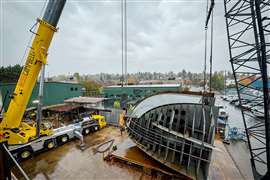Modern demands for telescopic crawler cranes
28 May 2013

Short set up time, manoeuvrability and pick and carry capability give telescopic crawler cranes major advantages, especially on long-term construction sites. As a result, they are becoming a favoured option for rental houses and end users choosing cranes for an increasingly wide range of applications.
“The advantages of a telescopic crane over a lattice boom crane are the short set-up times, easier transport, and the variability of the boom system,” explains Wolfgang Beringer, head of sales promotion at Liebherr-Werk Ehingen in Germany. “The telescopic boom can be extended or retracted fully automatically and rapidly to the desired length, allowing it to pass easily beneath obstacles. The crawler travel gear provides excellent off-road capacity and superb manoeuvrability, as well as allowing the crane to travel under full load.”
While available telescopic crawler cranes are focused at the lower end of the capacity scale, in 2012 Liebherr introduced its LTR 1220. The 220 tonner has a 60 metre boom that can be extended with a lattice jib up to 43 m long. The chassis offers improved off road mobility and can be easily relocated between job sites, the company says.
Another advantage of many telescopic crawler cranes is that the boom can be telescoped with a load on the hook, which is impossible to do with lattice boom cranes. Sennebogen’s new telescopic crawler, the 70 tonne capacity 673R, has a four section 36 m boom and two fly jib options of 8 and 15 m, which extend the maximum reach to 51 m. In addition, the crawler track width telescopes to quickly adjust the width of the machine for transport and for work in confined areas.
“The Sennebogen 673 R-HD performs impressively on the job with its highly robust design, compact dimensions and superior working and safety features,” Florian Attenhauser, Sennebogen marketing and PR manager, explains. The new 673 R-HD is the first telescopic crawler crane of the Sennebogen E-series.
Down the capacity scale is another recent offering from Liebherr, the 60 tonne capacity LTR 1060, a smaller brother to the 100 tonne capacity LTR 1100. Alongside being increasingly mobile, key features of the crane include compact dimensions and a weight of only 37.5 tonnes, Liebherr says. “The crawler travel gear provides excellent off road capacity and superb manoeuvrability, as well as allowing the crane to travel under full load,” Beringer explains.
Another new crawler in the sector is the Marchetti CW 25.35, which was launched at the Bauma 2013 exhibition in Munich, Germany, last month. Capacity is 25 tonnes and its maximum load moment is given as 57.6 tonne-metres. Its 25.1 metre boom can be extended with a jib to reach 33.2 m. Power comes from a 129 kW diesel engine.
Higher duty
Many of the telescopic crawler cranes already available are towards the heavy duty end of the application range. Demand for machinery suited to auger work and larger-scale foundation sector tasks is another industry trend that is affecting the design and function of telescopic crawlers. Japanese manufacturer Kobelco, for example, is promoting two telescopic crawler models, the TK750FS and the TK750S to meet this need.
These cranes are not new models but previously have only really been seen in Asia. They were shown at the Bauma exhibition in Germany last month. A feature is automatic boom extension and retraction, and despite its light weight, the boom is designed both for high strength and rigidity, a company spokesperson said. Supported on its crawler base it has 360 degree stability and capacity is maintained throughout at 1.25 tonnes at 26 m radius with a fully extended boom (at its minimum angle of elevation), even when only intermediate counterweight is used, the company adds.
To work comfortably in heavy duty applications, the TK750FS comes as standard with a third winch, which is capable of freefall operation. In addition, it has a lifting capacity of 5.5 tonnes at a 20 m working radius and a capacity of 18.5 tonnes with the fully extended boom set in an 8 m radius configuration. Maximum working radius is 27.8 m where capacity is 2.7 tonnes. Its minimum working radius with a fully extended boom is 3 m.
“Each boom section is fitted with a hydraulic cylinder for extension and retraction and extra rigidity at the attachment points,” explains Mark Evans, Kobelco Cranes sales manager, “This makes the machine ideally suited for heavy-duty foundation work using clamshell, as well as hammer-grab, vibro-hammer and auger attachments.”
Industry trends
Another factor driving change in the design of telescopic crawler cranes is their pick and carry ability. “This feature has been trending because while some cranes are able to pick the load, they are not as well suited for carrying the load from point A to point B,” Casey Smith, Link-Belt publicity co-ordinator, explains.
This requirement meant that Link-Belt included full pick and carry ability in its 100 tonne capacity TCC-1100 tele crawler. The crane comes with a 45.7 m five-section full power boom and a 48.6 m main boom tip height. It is transportable in four loads and power is from a 320 hp (239 kW) Cummins QSL Tier 4 diesel engine. Other features include a 20 degree tilting cab and cameras for the rear view and winch. There is also an optional three-piece bi-fold fly with an integral 3.08 metre tip extension, which, the company says, is ideal for two load line picks.
The TCC-1100 is the company’s third TCC (telescopic crawler crane) model to be introduced to the series. For ease of transport the crane uses lightweight nylon head sheaves, which helps bring the overall machine weight down while also increasing its lifting capacity, the company says. A result of this design means that the main unit transports at less than 40,370 kg with the crawler side frames removed.
Also majoring on the pick and carry theme is the new Tadano GTC300-EX, which was exhibited at Bauma 2013. It has a capacity of 27 tonnes at 3 metre radius and can lift the full crane load chart through 360 degrees, a company spokesperson said. The crawler has a three-section full power boom, which can be telescoped and raised with a full load on the hook. The fully extended boom is 24.4 m long. It fully extends in 70 seconds and elevates from -1 to 78 degrees.
Features of the Tadano crawler include a standard rated capacity limiter and an anti-two block system with audible and visual warnings. It also has an LCD screen that displays information, including working boom length, boom angle and working load radius. A planetary gear-driven single-speed winch is fitted, which has a single line speed of 69.8 m a minute (on the 4th layer).
The crawler also has rear view cameras, which display the winch as well as the blind area directly behind the crane, the company says. Optional equipment includes a boom extension of 6.1 m and a jib, which increases the maximum lifting height to 36.3 m. Power comes from a 129 Kw (173 hp) Cummins QSB 6.7 diesel engine.
Road regulations
As with other crane types, weight and dimensions for transport are equally important design factors for telescopic crawler cranes. To accommodate potential road and weight restrictions, the Kobelco TK750 series has a feature where the weight can be set to a rated load that reflects use with the intermediate counterweight only, or even without any counterweight.
“This feature comes with an automatic counterweight inspection system for safety,” a company spokesperson adds. “The minimum boom length of 9.99 metres and placing the winch behind the boom base, provides a high lifting capacity even on sites with height restrictions, such as under elevated structures.”
Keeping manoeuvrability in mind, the Sennebogen 673 R-HD is less than 3 m wide and, the manufacturer says, when travelling on the highway the machine can be transported quickly and easily. This is because it can comfortably be hauled on a long-distance flatbed truck. “The compact dimensions also come in handy, particularly in narrow working spaces. In addition to its use as a crane, the 673 R-HD can also operate as an aerial work platform rated to carry up to 1 tonne. This significantly expands the working range of the machine and enables a host of additional uses,” Attenhauser adds.
Another crawler which has a narrow track chassis is Liebherr’s LTR 11200. Designed to be suitable for work in wind turbine installations, the 1,200 tonne capacity crane can be moved fully erected on the narrow roads of wind turbine parks. Its telescopic boom is complemented by a Y-guy boom suspension system and range of lattice fly jibs. Its maximum capacity is calculated at 2.5 m radius and its maximum load moment is given as 3,200 tonne-metres. Its main boom can be telescoped to its maximum length of 100 m, increased with the jibs to a maximum outreach of 126 m.
Cleaner running
Like many other machines throughout the construction industry, telescopic crawler cranes are becoming increasingly green and environmentally friendly. As a spokesperson from Link-Belt points out, especially with regards to the Tier 4 Final emission regulations, crane manufacturers are striving to complete engine modifications by January 2014. “Link-Belt will also provide a power package that works in market regions where high sulphur fuels will still be used,” Casey Smith adds.
To meet existing emission demands, the Sennebogen 673 R-HD satisfies Tier 3b/4 emission standards. Power comes from a 160 kW Deutz engine, which has a combination of a soot particle filter and an exhaust after treatment system. “In addition, the machine offers significant energy savings in Eco Mode operating at a reduced engine speed,” Attenhauser adds.
Future place
For most end users and manufacturers, being able to use telescopic crawler cranes throughout the mainstream market is a positive move. Of course, being able to move quickly around a job site is a desirable option for operators and can save end users time and added cost, so telescopic crawlers can be the ideal choice, especially when compared to cranes that need additional supports.
As usual, manufacturers remain tight-lipped about plans for future additions to their telescopic crawler crane ranges but you can be sure that more are on their way. In addition to new entries around 70 tonnes, you might expect to see some around the 150 tonne capacity range, assuming that transportability issues can be resolved satisfactorily.



